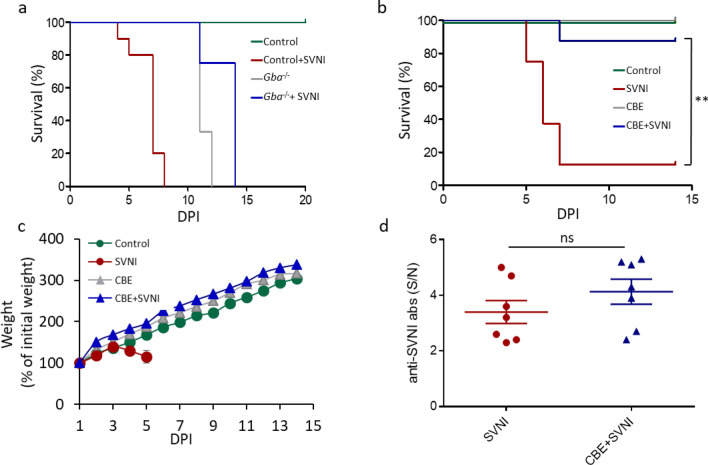Fig. 1.
nGD mice are more resistant to SVNI. a Survival curve of Gbaflox/flox; nestin-Cre mice (Gba−/−) and their respective Gbaflox/+; nestin-Cre mice littermate controls (control), uninfected or infected with a lethal dose (5 pfu) of SVNI on 16 day of age. n = 4 for control, n = 10 for SVNI, n = 3 for Gba−/−, n = 4 for Gba−/− + SVNI. b Survival rate of C57BL/6 mice untreated (control) or treated with CBE (50 mg/kg per day) from 13 day of age, uninfected or infected with a lethal dose (30 pfu) of SVNI on 21 days of age. (n = 8 mice/group). Log-rank test for comparisons of Kaplan–Meier survival curves indicated a significant decrease in the mortality of SVNI + CBE compared to SVNI mice. **p < 0.01. c Body weight (% of infection day 0) of C57BL/6 mice untreated (control) or treated with CBE (50 mg/kg per day) from 13 days of age, uninfected or infected with a lethal dose (30 pfu) of SVNI on 21 days of age. Results are mean ± SEM (n = 8 mice/group). In the SVNI group, only 3 mice survived 6 DPI, thus the last point on the graph is 5 DPI. d Serum levels of anti-SVNI antibodies in C57BL/6 mice untreated (control) or treated with CBE (50 mg/kg per day) from 13 days of age, uninfected or infected with a lethal dose (30 pfu) of SVNI on 21 days of age. Anti-SVNI antibody levels were measured by ELISA 5–6 DPI. The signal/noise (S/N) ratios of SVNI and CBE + SVNI were determined by dividing the mean absorbance of test sera with the mean absorbance of control and CBE mice, respectively. Results are mean ± SEM (n = 7 for infected groups, n = 3 for uninfected groups). Statistical analysis was performed using a two-tailed unpaired t-test. ns not significant

